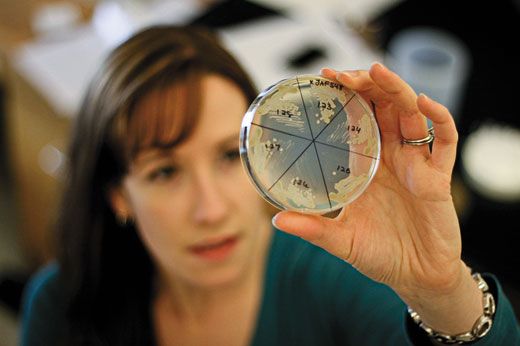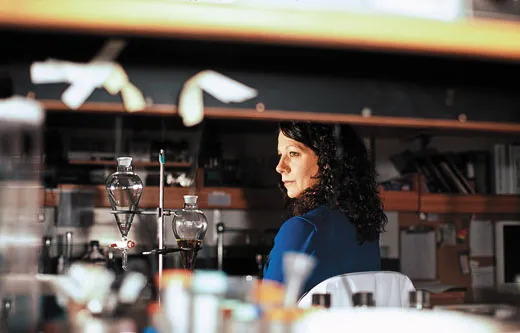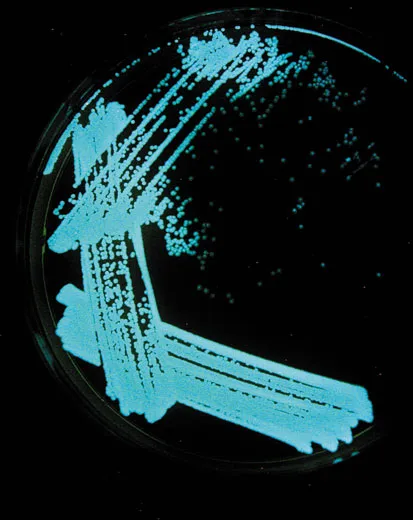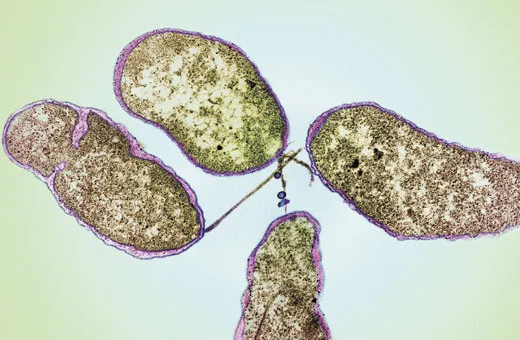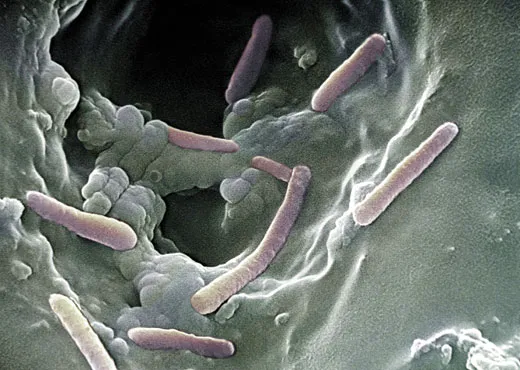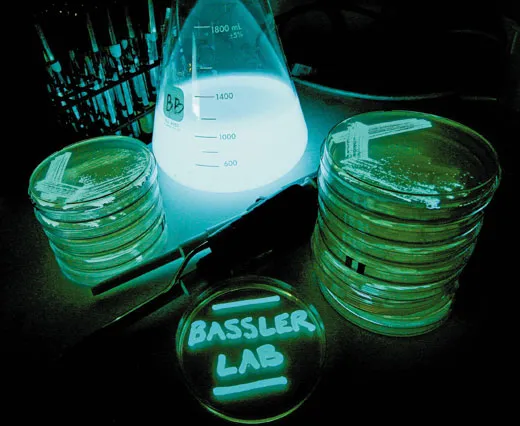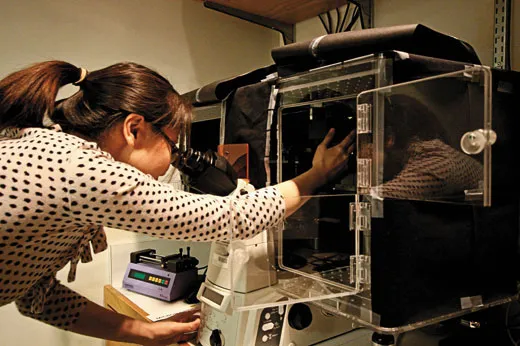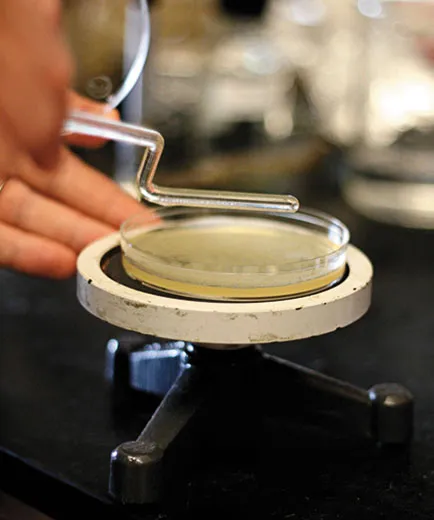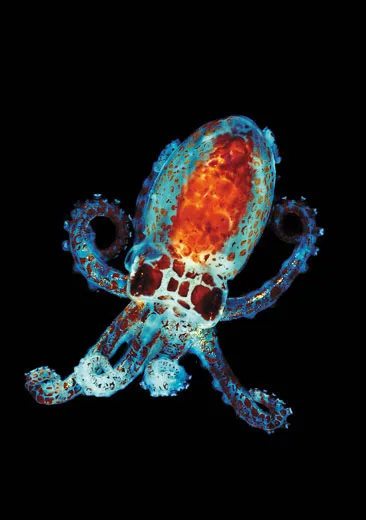Listening to Bacteria
By studying microbial communications, Bonnie Bassler has come up with new ways to treat disease
/https://tf-cmsv2-smithsonianmag-media.s3.amazonaws.com/filer/Bacteria-Bonnie-Bassler-631.jpg)
Bonnie Bassler, her shoes kicked off, knees up and socked feet pressed against the rim of the conference room table, watches with an air of droll expectation as a researcher in her world-renowned microbiology laboratory at Princeton University stands up to present his latest experimental results to the other members of her team. Yunzhou Wei is known for his campy presentations, and he does not disappoint. Slides of the cast members of his favorite television crime series flash on the screen and he launches a brief, sportive discussion of the lessons the scientists might extract from the shows: Trust your instincts! But look for evidence, too! Then a far more pressing question arises: which TV character would Bassler want to play? The genius behavioral analyst? No, no, not the “nerdy guy,” Bassler grumbles. Well, how about the prim and pretty forensic anthropologist? No, the celebrated scientist’s mind is made up. “I want to be her,” Bassler says, pointing at Special Agent Jennifer “JJ” Jareau, the Nordic bombshell on the CBS program “Criminal Minds.” Case closed, Bassler says. “Let’s get back to molecules now.”
The character of Jareau suits Bassler remarkably well. Jareau is the communications point person of her group, the media liaison between the FBI and the outside world. Bassler, 48, has been fabulously successful in her career, winning laurels like a MacArthur Foundation “genius” award, membership in the National Academy of Sciences, a coveted position with the Howard Hughes Medical Institute and the presidency of the American Society for Microbiology. And all that can be traced to her deep appreciation for the power of communication. Messaging is the medium in which Bassler shines.
Bassler is at the forefront of the fast-growing field of “quorum sensing,” the study of how microbes communicate with each other as they go about building the vast interlocking infrastructure of life on which we macrobes depend. In recent years she and other microbiologists have discovered that bacteria are not the dull solipsists of long-standing reputation, content to merely suck in food, double in size, divide down the middle and repeat ad infinitum, attending to nothing but their obtuse, unicellular selves. Instead, bacteria turn out to be the original newshounds, glued to their cellphones and Internet chat lines. They converse in a complex chemical language, using molecules to alert one another to who’s out there, in what numbers and how best to behave given the present company. Bacteria survey their ranks, they count heads, and if the throng is sufficiently large and like-minded—if there is a quorum—they act. Through chemical signaling, tiny bacterial cells can band together and perform the work of giants. They can compost an elephant, fertilize an oak forest or light up the oceans in the eerie teal glow of bioluminescence. Some bacterial collusions are far less charming and do real harm. Molecular communication allows 600 different species of bacteria to organize themselves into the slimy dental plaque that leads to tooth decay, for example, and it likely enables the nasty pathogens that cause streptococcal pneumonia or bubonic plague to time the release of their toxins for maximum impact on their human hosts.
In deciphering the nuances of bacterial communication, biologists have learned that the lexicons come in two distinct styles: private and public. Every bacterial species has its own dialect, a molecular signature that can be understood only by others of its kind. Bassler made her fame discovering that bacteria also traffic in the second, more universally recognized set of signals that seems to serve as bacterial Esperanto. “Bacteria can talk to each other,” she says. “Not only can they talk, but they are multilingual.”
“Bonnie is the champion of bacterial conversations,” says Richard Losick, a microbiologist at Harvard University. “This is a field that goes back to the 1970s, but she has re-energized it in a remarkable way.”
“Her work is groundbreaking,” says Jo Handelsman, a microbiologist at Yale University. “We used to think of bacterial communication as something species specific, but she’s really opened up the possibility that interspecies communication is a big part of the quorum-sensing story.”
Amusingly enough, the scientist who helped divulge that bacteria are polyglot is herself...not. “What do you expect?” she mutters. “I’m an American! I speak English!”
Bassler’s foray into microbial idioms is of more than academic interest. The work may well have an impact on what the Centers for Disease Control and Prevention calls one of the “most pressing public health problems” in the world today: antibiotic resistance. In recent years, the overuse of drugs like penicillin to treat childhood earaches, or to inoculate livestock crowded together on factory farms, has spawned the appearance of “superbugs,” bacterial strains able to shrug off virtually any of the conventional antibiotics lobbed at them.
Bassler and her peers are guardedly optimistic that their insights into the circuitry of quorum sensing will eventually yield a new, safer generation of antibiotics. Rather than seeking to kill bacteria outright, as current antibiotics do—an approach that readily leads to drug resistance—the novel therapeutics would simply muzzle the molecular messages that induce bacteria to cause disease. Bassler explains the difference between the two approaches this way: “Let’s say I’m a bacterium, and you’re hitting me with a drug like penicillin that pops the bacterial membrane, but I happen to have a mutation that makes me impervious to that popping effect,” she says. “No question about it, I’ll have an immediate growth advantage.”
But let’s say you are instead using an anti-quorum-sensing drug designed to inhibit bacterial communication, she continues, “and I’m a bacterium with a mutation that makes me immune to the blocker.” Great: I’m a microbe that’s trying to get in touch with my friends, but because of the blocker, nobody around me is listening. If virulence depends on effective bacterial communication, she says, my lone little mutation will give me no growth advantage at all: “What good does it do me?”
Thomas Silhavy, a microbiologist at Princeton who headed the faculty committee that hired Bassler 16 years ago (“I hit a home run,” he says of hiring her. “I hit it out of the park”), is among those with high hopes for eventual spinoffs from quorum-sensing studies. “Of course, it’s always a big, multimillion-dollar challenge to turn basic research into an FDA-approved drug,” he says. “But I think there’s a very real chance this approach will work and give us new tools for intervening in particular diseases.” He cites the case of cystic fibrosis, a congenital disorder in which mucus builds up in the lungs and hosts colonies of bacteria called pseudomonas. Infections that normal adults would readily brush away can fulminate for years in cystic fibrosis patients, until one day the chronic turns virulent and overwhelms the body: uncontrollable pseudomonas infection is a major cause of death among people with the disease. Scientists have traced the onset of virulence to the release of quorum-sensing molecules, the chemical messengers that incite the bacteria to begin operating as a group. In theory, Silhavy says, a drug that blocked the pseudomonal calls to mayhem could prove invaluable in the treatment of the devastating disorder.
Bassler and other researchers have identified a number of molecules that disrupt quorum sensing in test-tube experiments with pseudomonas and cholera bacteria; the test molecules seem to protect worms exposed to the virulent microbes. Bassler even tried her hand at drug development with a start-up company a few years ago. The effort foundered, and she is the first to concede that a medication based on the approach is probably a decade or more away. Nevertheless, the possibility of her work someday being translated from the lab bench to the bedside is part of her ongoing inspiration.
“We’re scientists, we’re curious about how nature works, but we’re also do-gooders,” she says. “It’s fantastic to think that the same experiments we’d do to understand how information gets into cells could have a practical side to them, too.”
It’s a sunny Saturday in Philadelphia, and outdoors, in a park, is where most people might choose to be. Yet the lecture hall at the Wagner Free Institute of Science, with its dim amber lighting, wooden chairs, dried blowfish, human skulls and other Victorian bric-a-brac, is full of people mesmerized by the woman up front, who seems to be carrying her own piece of sun. Bassler’s communication skills are not confined to divining petri dish dishings. She is a dynamo of a public speaker, who regularly dazzles both professional and lay audiences like this one with her vivid descriptions of microbial politics. “She can be very charismatic, but with just enough geekiness to let you know she’s a serious scientist,” says Stephen Winans of Cornell University. People love her dry humor and her blend of merry diva grandeur and aw-shucks insistence that she is just an “imposter” who does “genetics for dopes.”
“Bacteria are the oldest organisms on earth,” Bassler booms from the stage. “They’ve been here for four billion years. They make up 50 percent of the biomass of the earth and nearly 100 percent of its biodiversity.”
If you think bacteria, you probably think disease, putrefaction and germs, and reach for your hand sanitizer. Bassler wants to set you straight. “You live in intimate association with bacteria, and you couldn’t survive without them,” she says. Trillions of human cells make up the human body, but there are at least ten times that number of bacterial cells in you or on you. You are, at best, only 10 percent human. Bacteria coat your skin in an ultrathin protective armor, which helps keep harmful microbes at bay. The bacteria in your gut make vitamins K and B12. You like lettuce? Your intestinal flora gamely generate enzymes so you can digest it. It’s a happy trans-taxa tit-for-tat affair. For bacteria, “it’s the good life, it’s fat city” to dwell in the rich environs of a human being, Bassler says. It’s much better, she goes on, than striking out on their own “in a puddle or free-living in the ocean. Those are nutrient deserts compared to us.” Bacteria may be microscopic—three million can fit onto a pinhead—but they are not invisible. The next time you visit the Grand Canyon and your heart soars at the splendid strawberry-rhubarb striations of rock, take a moment to thank the makers. “Bacteria mineralized the rocks, they deposited the iron,” Bassler says. “They made the geology we see.”
Bassler lives not far from the Princeton campus with her husband, Todd Reichart, and their cat, Spark. Reichart, 48, is an actor and Web page designer. Their 1915 house is compact and elegant and the rooms are all painted different bright colors. “We’re not afraid of color,” Bassler says, “and color is something we agree on.” The two have what a friend describes as a “playfully sparring” relationship. She complains he’s a slob. He complains she doesn’t listen. “Are you still here?” she says, glaring at him. “Don’t you have somewhere to be?” Sorry, Bonnie, he says. “I’m a festering fact of your life.” But when he does finally leave for the evening, she says, “We really do enjoy being together and doing things together. Todd is my biggest fan.” They tried to have children, but it didn’t happen. “It’s not like there’s a void,” she says. “I’m a happy person. He’s a happy man. We have an amazingly rich life, and I have all these kids in my lab.”
Bassler grew up in Miami and later in Danville, California, with her businessman father, stay-at-home mother, older sister, Elissa, and younger brother, Rod. She had Barbie dolls; she was also a jock. “I was a huge athlete as a kid,” she said. “I was on every sports team.” She was a good student as well, and when she slacked off, her mother nudged her back in line. “She would tell me that when she was in college, a woman could only be one of two things, a teacher or a nurse,” says Bassler. “But you, she’d say, you can be anything you want.” Seeing that Bonnie loved animals, her mother found her a volunteer position at a zoo in Miami. “I got to be in there with the camels, operate on a lion,” said Bassler. “It was the coolest job in the world.” Later her mother helped her secure a position at a Kaiser Aluminum facility near Danville, testing bauxite samples from mines. “That’s how I put myself through college,” says Bassler. “I found that I loved working in a lab.” She attended the University of California at Davis and decided to major in biochemistry.
Bassler was just 21 years old when her mother was diagnosed with metastatic colon cancer. Three months later, at the age of 46, she died. The loss is a void that Bassler can’t seem to seal. “I’m older now than she was,” says Bassler, her eyes rimmed with tears. “God, what a rip-off.”
“I wish I could tell her that all the yelling at me to study and setting the timer when I was practicing piano was worth it,” she says. “I wish I could tell her how great this life is.”
Bassler assigns a time and place to the beginning of the great part of her life: the day of a lecture in graduate school when she first learned about the bobtail squid and its amazing bacteria-colored dream cloak. The squid lives off the coast of Hawaii and spends its days safely buried in the sand, emerging at night to hunt. It hovers near the surface of the water and waits for food, such as brine shrimp, to pass by. To avoid casting a shadow that would blow its cover, the squid uses a little trick. Under its protective outer sheath, or mantle, are lobes bulging with bioluminescent bacteria, billions and billions of Vibrio fischeri chemically glowing a cool cobalt blue. The squid can sense how much moonlight is hitting it, and it adjusts apertures on its glowing lobes accordingly. With light from above and below balanced, the squid can hunt shadow-free. The squid gets camouflage, the bacteria get shelter and nutrients, and scientists like Bassler get a magnificent system to ply, one where the “aha!” light bulb is more than a metaphor.
Through studying V. fischeri, researchers learned about bacterial sociability. They found that the bacteria would luminesce only when they were in a crowd, packed together, and would desist from glowing should they float away from their fellows in the lonely dilution of the sea. The researchers isolated the molecule that allowed the bacteria to keep track of one another; they called it an autoinducer.
After earning her doctorate in biochemistry at Johns Hopkins University, Bassler worked as a postdoctoral fellow at the Agouron Institute, a research foundation in La Jolla. While there she fell hard for blinking squid and other lanterns of the sea. She studied V. fischeri and moved on to a related species called Vibrio harveyi. She liked the ease of manipulating bacteria, how she could make mutants, push genes around, cross and backcross strains. She especially liked that her weird luminous workhorses would glow if she did the right thing but not if the experiment flopped, a visible indicator that her research team still takes advantage of today. “If you can turn off the light switch in my lab,” Bassler says, “you’re good.”
It was while studying V. harveyi that Bassler helped make a couple of key discoveries: first, that V. harveyi had its own, chemically distinct version of an autoinducer, a members-only signal for keeping track of local V. harveyi numbers; second, that both V. harveyi and V. fischeri secreted and responded to another sort of molecule. This molecule was able to get a rise out of V. harveyi and V. fischeri alike, regardless of its source. Bassler had stumbled on her bacterial Esperanto. She dubbed the molecule autoinducer 2, and pretty soon she was finding it in virtually every bacteria species she tested: in shigella, salmonella, E. coli and Yersinia pestis, the bearer of plague.
Bassler and her colleagues have examined the molecule in atomic detail and seen what it looks like when it is clasped by its appropriate sensory protein—the “ear” that allows bacterial cells to hear the molecule’s cry. They have begun charting precisely how different species of bacteria respond to the universal signal when it is delivered either alone or in combination with other quorum-sensing molecules. They have shown, for example, that when cholera bacteria receive a mix of the private cholera-only signals and the shared we’re-all-bacteria-in-this-together signal, the cholera microbes become extremely virulent. They have found that the common-language molecules are micromanaged by cellular busybodies called small RNAs. They have found that the system is...complicated. “It’s fun, but it’s hard,” says Bassler. “And that’s good, because I need the job.”
Most interesting people have their share of contradictions, but Bonnie Bassler is like a Greek diner menu of contradictions: every time you think you’ve reached the end, you unstick another page of options. She is proud. She is humble. She is impatient. She’s a saint. She has a coffee cup that says “Diva,” but she freely shares her insecurities. “I’m so worried that my star is falling, that I’ll run out of juice.” She jokes about being bored and wanting to go home, but to anyone who works with her she is a perpetual anti-boredom machine.
“Her enthusiasm is very contagious, and it’s always contagious,” says graduate student Carey Nadell. “After the first few conversations we had, when she’d get me excited about the science, I thought the effect would wear off, the way it does with most things. But that hasn’t happened. I always become happier about doing the science after talking with her.” That cheerleader spirit is not limited to science. Monday through Friday, Bassler is up by 5:40 a.m. and goes to the local YMCA, where she teaches aerobics for an hour. “It’s a very challenging class,” says Jean Schwarzbauer, a Princeton molecular biologist who is one of Bassler’s closest friends and a fellow gym rat. “People come thinking aerobics is something to work up to, but she gives you a day to get used to it and then she starts yelling—in a friendly way—if you’re not working hard enough.” Customers come back for more. “You see a lot of the same people over and over,” says Schwarzbauer. “She calls it a cult.”
Some of her scientific peers have complained that Bassler sometimes hogs the spotlight. “I think she’s a very talented scientist and I’ve promoted her career,” says Peter Greenberg, who studies quorum sensing at the University of Washington. He added, however, that Bassler can have “a tough time” giving others credit. Bassler admits that she’s a “ham” and that she’s glad her last name begins with B so that she’s at the top of her department’s Web page. Yet she is also a zealous collaborator, forever seeking new people to work with: chemists, physicists, X-ray crystallographers, structural biologists, mathematicians, evolutionary theorists. She met a condensed-matter physicist while standing around the baggage claim at a Mexican airport, and the next thing you knew she was collaborating with him. A student in Bassler’s lab named Julie Semmelhack happened to mention to her father, Marty Semmelhack, that she’d been working on an interesting molecule in the lab. The father, a chemist, instantly recognized the structural profile of the molecule—“It’s a furanone!”—so of course Bassler had to work with him, too.
“Working with Bonnie has convinced me that under the right circumstances and with the right people, collaboration can be more rewarding than working for yourself,” says Frederick Hughson, a molecular biologist at Princeton who studies the structure of proteins and other molecules.
Scientists of Bassler’s caliber often have 50 or 60 people working for them, all vying for attention and hot projects. Bassler has 15 or 16 people in her lab, and she prides herself on picking her protégés well. “Only two people haven’t worked out in all these years,” she says. Her requirements are simple. If you want to work in her lab, if you want to be part of the Bonnie Bassler “brand,” as she puts it, you must be extremely ambitious, self-motivated, smart, tenacious, handy with a pipette and not a jerk. “My group selects for a certain kind of person, and that person tends to be really, really nice,” she says. “After all, they’re the ones who will be working with them elbow to elbow for five years, and they notice these things.” A candidate visits the lab, and members tell Bassler what they think. “It’s quorum sensing,” she says.
Members of her lab are clearly wedded to Bassler. Some have even been wedded by her. Last year, when Yunzhou Wei was planning his nuptials, he heard from another scientist at Princeton that Bassler was licensed to perform wedding ceremonies.
“I sent a dollar to a church on the Web, and I got the certificate,” Bassler says. “I’m sure it’s a complete tax scam.” She’d already officiated at two weddings and a baptism when Wei asked her to do the honors. “I’m a sucker,” Bassler sighs.
“We had 60 people come from all around the country,” says Wei. “Bonnie made a really good ceremony. It brought us all very close together.”
With people, as with bacteria, nothing is stronger than community, united in purpose by just the right words.
Natalie Angier is a Pulitzer Prize-winning science writer and the author of The Canon, Natural Obsessions and other books.
